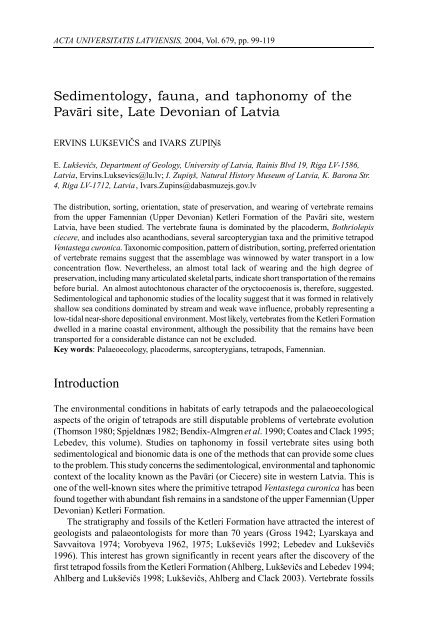Zemes un vides zinātnes Earth and Environment Sciences - Latvijas ...
Zemes un vides zinātnes Earth and Environment Sciences - Latvijas ...
Zemes un vides zinātnes Earth and Environment Sciences - Latvijas ...
Create successful ePaper yourself
Turn your PDF publications into a flip-book with our unique Google optimized e-Paper software.
ACTA UNIVERSITATIS LATVIENSIS, 2004, Vol. 679, pp. 99-119<br />
Sedimentology, fa<strong>un</strong>a, <strong>and</strong> taphonomy of the<br />
Pavāri site, Late Devonian of Latvia<br />
ERVINS LUKšEVIČS <strong>and</strong> IVARS ZUPIŅš<br />
E. Lukševičs, Department of Geology, University of Latvia, Rainis Blvd 19, Riga LV-1586,<br />
Latvia, Ervins.Luksevics@lu.lv; I. Zupiņš, Natural History Museum of Latvia, K. Barona Str.<br />
4, Riga LV-1712, Latvia, Ivars.Zupins@dabasmuzejs.gov.lv<br />
The distribution, sorting, orientation, state of preservation, <strong>and</strong> wearing of vertebrate remains<br />
from the upper Famennian (Upper Devonian) Ketleri Formation of the Pavāri site, western<br />
Latvia, have been studied. The vertebrate fa<strong>un</strong>a is dominated by the placoderm, Bothriolepis<br />
ciecere, <strong>and</strong> includes also acanthodians, several sarcopterygian taxa <strong>and</strong> the primitive tetrapod<br />
Ventastega curonica. Taxonomic composition, pattern of distribution, sorting, preferred orientation<br />
of vertebrate remains suggest that the assemblage was winnowed by water transport in a low<br />
concentration flow. Nevertheless, an almost total lack of wearing <strong>and</strong> the high degree of<br />
preservation, including many articulated skeletal parts, indicate short transportation of the remains<br />
before burial. An almost autochtonous character of the oryctocoenosis is, therefore, suggested.<br />
Sedimentological <strong>and</strong> taphonomic studies of the locality suggest that it was formed in relatively<br />
shallow sea conditions dominated by stream <strong>and</strong> weak wave influence, probably representing a<br />
low-tidal near-shore depositional environment. Most likely, vertebrates from the Ketleri Formation<br />
dwelled in a marine coastal environment, although the possibility that the remains have been<br />
transported for a considerable distance can not be excluded.<br />
Key words: Palaeoecology, placoderms, sarcopterygians, tetrapods, Famennian.<br />
Introduction<br />
The environmental conditions in habitats of early tetrapods <strong>and</strong> the palaeoecological<br />
aspects of the origin of tetrapods are still disputable problems of vertebrate evolution<br />
(Thomson 1980; Spjeldnæs 1982; Bendix-Almgren et al. 1990; Coates <strong>and</strong> Clack 1995;<br />
Lebedev, this volume). Studies on taphonomy in fossil vertebrate sites using both<br />
sedimentological <strong>and</strong> bionomic data is one of the methods that can provide some clues<br />
to the problem. This study concerns the sedimentological, environmental <strong>and</strong> taphonomic<br />
context of the locality known as the Pavāri (or Ciecere) site in western Latvia. This is<br />
one of the well-known sites where the primitive tetrapod Ventastega curonica has been<br />
fo<strong>un</strong>d together with ab<strong>un</strong>dant fish remains in a s<strong>and</strong>stone of the upper Famennian (Upper<br />
Devonian) Ketleri Formation.<br />
The stratigraphy <strong>and</strong> fossils of the Ketleri Formation have attracted the interest of<br />
geologists <strong>and</strong> palaeontologists for more than 70 years (Gross 1942; Lyarskaya <strong>and</strong><br />
Savvaitova 1974; Vorobyeva 1962, 1975; Lukševičs 1992; Lebedev <strong>and</strong> Lukševičs<br />
1996). This interest has grown significantly in recent years after the discovery of the<br />
first tetrapod fossils from the Ketleri Formation (Ahlberg, Lukševičs <strong>and</strong> Lebedev 1994;<br />
Ahlberg <strong>and</strong> Lukševičs 1998; Lukševičs, Ahlberg <strong>and</strong> Clack 2003). Vertebrate fossils
















